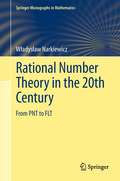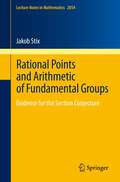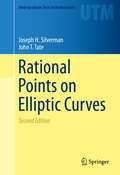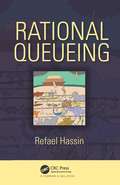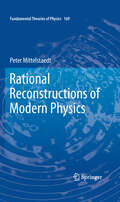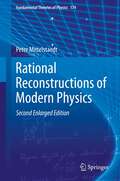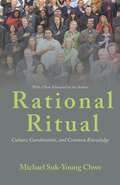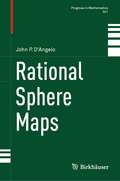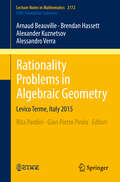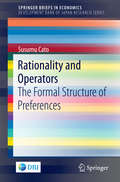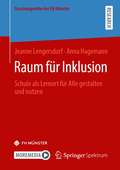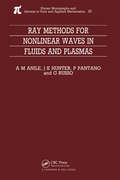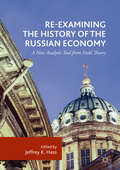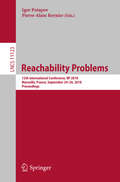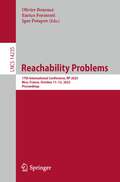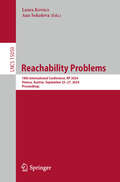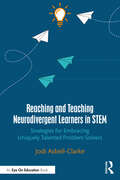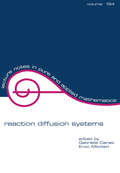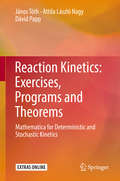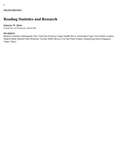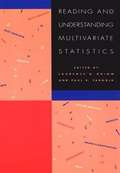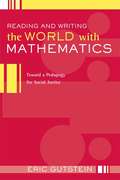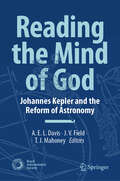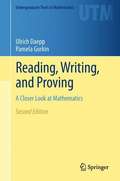- Table View
- List View
Rational Number Theory in the 20th Century
by Władysław NarkiewiczThe last one hundred years have seen many important achievements in the classical part of number theory. After the proof of the Prime Number Theorem in 1896, a quick development of analytical tools led to the invention of various new methods, like Brun's sieve method and the circle method of Hardy, Littlewood and Ramanujan; developments in topics such as prime and additive number theory, and the solution of Fermat's problem. Rational Number Theory in the 20th Century: From PNT to FLT offers a short survey of 20th century developments in classical number theory, documenting between the proof of the Prime Number Theorem and the proof of Fermat's Last Theorem. The focus lays upon the part of number theory that deals with properties of integers and rational numbers. Chapters are divided into five time periods, which are then further divided into subject areas. With the introduction of each new topic, developments are followed through to the present day. This book will appeal to graduate researchers and student in number theory, however the presentation of main results without technicalities will make this accessible to anyone with an interest in the area.
Rational Points and Arithmetic of Fundamental Groups
by Jakob StixThe section conjecture in anabelian geometry, announced by Grothendieck in 1983, is concerned with a description of the set of rational points of a hyperbolic algebraic curve over a number field in terms of the arithmetic of its fundamental group. While the conjecture is still open today in 2012, its study has revealed interesting arithmetic for curves and opened connections, for example, to the question whether the Brauer-Manin obstruction is the only one against rational points on curves. This monograph begins by laying the foundations for the space of sections of the fundamental group extension of an algebraic variety. Then, arithmetic assumptions on the base field are imposed and the local-to-global approach is studied in detail. The monograph concludes by discussing analogues of the section conjecture created by varying the base field or the type of variety, or by using a characteristic quotient or its birational analogue in lieu of the fundamental group extension.
Rational Points on Elliptic Curves
by Joseph H. Silverman John T. TateThe theory of elliptic curves involves a pleasing blend of algebra, geometry, analysis, and number theory. This volume stresses this interplay as it develops the basic theory, thereby providing an opportunity for advanced undergraduates to appreciate the unity of modern mathematics. At the same time, every effort has been made to use only methods and results commonly included in the undergraduate curriculum. This accessibility, the informal writing style, and a wealth of exercises make Rational Points on Elliptic Curves an ideal introduction for students at all levels who are interested in learning about Diophantine equations and arithmetic geometry. Most concretely, an elliptic curve is the set of zeroes of a cubic polynomial in two variables. If the polynomial has rational coefficients, then one can ask for a description of those zeroes whose coordinates are either integers or rational numbers. It is this number theoretic question that is the main subject of Rational Points on Elliptic Curves. Topics covered include the geometry and group structure of elliptic curves, the Nagell-Lutz theorem describing points of finite order, the Mordell-Weil theorem on the finite generation of the group of rational points, the Thue-Siegel theorem on the finiteness of the set of integer points, theorems on counting points with coordinates in finite fields, Lenstra's elliptic curve factorization algorithm, and a discussion of complex multiplication and the Galois representations associated to torsion points. Additional topics new to the second edition include an introduction to elliptic curve cryptography and a brief discussion of the stunning proof of Fermat's Last Theorem by Wiles et al. via the use of elliptic curves.
Rational Queueing (Chapman & Hall/CRC Series in Operations Research)
by Refael HassinUnderstand the Strategic Behavior in Queueing SystemsRational Queueing provides one of the first unified accounts of the dynamic aspects involved in the strategic behavior in queues. It explores the performance of queueing systems where multiple agents, such as customers, servers, and central managers, all act but often in a noncooperative manner.T
Rational Reconstructions of Modern Physics
by Peter MittelstaedtNewton’s classical physics and its underlying ontology are loaded with several metaphysical hypotheses that cannot be justified by rational reasoning nor by experimental evidence. Furthermore, it is well known that some of these hypotheses are not contained in the great theories of modern physics, such as the theory of relativity and quantum mechanics. This book shows that, on the basis of Newton’s classical physics and by rational reconstruction, the theory of relativity as well as quantum mechanics can be obtained by partly eliminating or attenuating the metaphysical hypotheses. Moreover, it is shown that these reconstructions do not require additional hypotheses or new experimental results.
Rational Reconstructions of Modern Physics, 2nd Enlarged Edition
by Peter MittelstaedtNewton's classical physics and its underlying ontology are loaded with several metaphysical hypotheses that cannot be justified by rational reasoning nor by experimental evidence. Furthermore, it is well known that some of these hypotheses are not contained in the great theories of Modern Physics, such as the theory of Special Relativity and Quantum Mechanics. This book shows that, on the basis of Newton's classical physics and by rational reconstruction, the theory of Special Relativity as well as Quantum Mechanics can be obtained by partly eliminating or attenuating the metaphysical hypotheses. Moreover, it is shown that these reconstructions do not require additional hypotheses or new experimental results. <P><P> In the second edition the rational reconstructions are completed with respect to General Relativity and Cosmology. In addition, the statistics of quantum objects is elaborated in more detail with respect to the rational reconstruction of quantum mechanics. The new material completes the approach of the book as much as it is possible at the present state of knowledge. Presumably, the most important contribution that is added to the second edition refers to the problem of interpretation of the three great theories of Modern Physics. It is shown in detail that in the light of rational reconstructions even realistic interpretations of the three theories of Modern Physics are possible and can easily be achieved.
Rational Ritual: Culture, Coordination, and Common Knowledge
by Michael Suk-Young ChweWhy do Internet, financial service, and beer commercials dominate Super Bowl advertising? How do political ceremonies establish authority? Why does repetition characterize anthems and ritual speech? Why were circular forms favored for public festivals during the French Revolution? This book answers these questions using a single concept: common knowledge. Game theory shows that in order to coordinate its actions, a group of people must form "common knowledge." Each person wants to participate only if others also participate. Members must have knowledge of each other, knowledge of that knowledge, knowledge of the knowledge of that knowledge, and so on. Michael Chwe applies this insight, with striking erudition, to analyze a range of rituals across history and cultures. He shows that public ceremonies are powerful not simply because they transmit meaning from a central source to each audience member but because they let audience members know what other members know. For instance, people watching the Super Bowl know that many others are seeing precisely what they see and that those people know in turn that many others are also watching. This creates common knowledge, and advertisers selling products that depend on consensus are willing to pay large sums to gain access to it. Remarkably, a great variety of rituals and ceremonies, such as formal inaugurations, work in much the same way. By using a rational-choice argument to explain diverse cultural practices, Chwe argues for a close reciprocal relationship between the perspectives of rationality and culture. He illustrates how game theory can be applied to an unexpectedly broad spectrum of problems, while showing in an admirably clear way what game theory might hold for scholars in the social sciences and humanities who are not yet acquainted with it. In a new afterword, Chwe delves into new applications of common knowledge, both in the real world and in experiments, and considers how generating common knowledge has become easier in the digital age.
Rational Sphere Maps (Progress in Mathematics #341)
by John P. D’AngeloThis monograph systematically explores the theory of rational maps between spheres in complex Euclidean spaces and its connections to other areas of mathematics. Synthesizing research from the last forty years, the author aims for accessibility by balancing abstract concepts with concrete examples. Numerous computations are worked out in detail, and more than 100 optional exercises are provided throughout for readers wishing to better understand challenging material.The text begins by presenting core concepts in complex analysis and a wide variety of results about rational sphere maps. The subsequent chapters discuss combinatorial and optimization results about monomial sphere maps, groups associated with rational sphere maps, relevant complex and CR geometry, and some geometric properties of rational sphere maps. Fifteen open problems appear in the final chapter, with references provided to appropriate parts of the text. These problems will encourage readers to apply the material to future research.Rational Sphere Maps will be of interest to researchers and graduate students studying several complex variables and CR geometry. Mathematicians from other areas, such as number theory, optimization, and combinatorics, will also find the material appealing.
Rationality Problems in Algebraic Geometry
by Brendan Hassett Alexander Kuznetsov Arnaud Beauville Alessandro Verrarita Pardini Gian Pietro PirolaProviding an overview of the state of the art on rationality questions in algebraic geometry, this volume gives an update on the most recent developments. It offers a comprehensive introduction to this fascinating topic, and will certainly become an essential reference for anybody working in the field. Rationality problems are of fundamental importance both in algebra and algebraic geometry. Historically, rationality problems motivated significant developments in the theory of abelian integrals, Riemann surfaces and the Abel-Jacobi map, among other areas, and they have strong links with modern notions such as moduli spaces, Hodge theory, algebraic cycles and derived categories. This text is aimed at researchers and graduate students in algebraic geometry.
Rationality and Operators
by Susumu CatoThis unique book develops an operational approach to preference and rationality as the author employs operators over binary relations to capture the concept of rationality. A preference is a basis of individual behavior and social judgment and is mathematically regarded as a binary relation on the set of alternatives. Traditionally, an individual/social preference is assumed to satisfy completeness and transitivity. However, each of the two conditions is often considered to be too demanding; and then, weaker rationality conditions are introduced by researchers. This book argues that the preference rationality conditions can be captured mathematically by "operators," which are mappings from the set of operators to itself. This operational approach nests traditional concepts in individual/social decision theory and clarifies the underlying formal structure of preference rationality. The author also applies his approach to welfare economics. The core problem of 'new welfare economics,' developed by Kaldor, Hicks, and Samuelson, is the rationality of social preference. In this book the author translates the social criteria proposed by those three economists into operational forms, which provide new insights into welfare economics extending beyond 'new welfare economics. '
Raum für Inklusion: Schule als Lernort für Alle gestalten und nutzen (Forschungsreihe der FH Münster)
by Jeanne Lengersdorf Anna HagemannDer Raum gewinnt zunehmend an Bedeutung. Gerade in Zeiten des pädagogischen Wandels und mit der Unterzeichnung der UN-Konvention über die Rechte von Menschen mit Behinderung rückt konstruktivistisch, inklusiv ausgelegte Didaktik in den Vordergrund schulischer Entwicklungen. Dieses Buch geht der Frage nach, wie sich Schule als Lernort für Alle gestalten und nutzen lässt. Dazu wird unter den Schwerpunkten Beziehungsebene, Multiprofessionelle Teamarbeit, individualisiertes Lernen und Ort des Lernens anhand einer Triangulation von empirischen Forschungsmethoden eine inklusive berufliche Schule in Hamburg beleuchtet. Im Mittelpunkt der Arbeit steht das Zusammenspiel von Raum und Pädagogik unter dem Leitgedanken der Inklusion.Die AutorinnenAnna Hagemann, M. Ed., Lehramt an Berufskollegs in der beruflichen Fachrichtung Mediendesign und Designtechnik und dem allgemeinbilden Fach EnglischJeanne Lengersdorf, M. Ed., Lehramt an Berufskollegs in der beruflichen Fachrichtung Mediendesign und Designtechnik und dem allgemeinbilden Fach Sport, seit 2019 wissenschaftliche Mitarbeiterin an der FH Münster am Institut für Berufliche Lehrerbildung (abgeordnet von der WWU Münster)
Ray Methods for Nonlinear Waves in Fluids and Plasmas (Monographs And Surveys In Pure And Applied Mathematics Ser.)
by Marcelo Anile P Pantano G Russo J HunterPresents in a systematic and unified manner the ray method, in its various forms, for studying nonlinear wave propagation in situations of physical interest, essentially fluid dynamics and plasma physics.
Ray Tracing and Beyond
by Aptara. Inc E. R. TracyThis complete introduction to the use of modern ray tracing techniques in plasma physics describes the powerful mathematical methods generally applicable to vector wave equations in non-uniform media, and clearly demonstrates the application of these methods to simplify and solve important problems in plasma wave theory. Key analytical concepts are carefully introduced as needed, encouraging the development of a visual intuition for the underlying methodology, with more advanced mathematical concepts succinctly explained in the appendices, and supporting Matlab and Raycon code available online. Covering variational principles, covariant formulations, caustics, tunnelling, mode conversion, weak dissipation, wave emission from coherent sources, incoherent wave fields, and collective wave absorption and emission, all within an accessible framework using standard plasma physics notation, this is an invaluable resource for graduate students and researchers in plasma physics.
Re-Examining the History of the Russian Economy: A New Analytic Tool from Field Theory
by Jeffrey K. HassThis book explores the application of field theory (patterns of interaction) to Russian economic history, and how social and political fields mediate the influences of institutions, structures, discourses and ideologies in the creation and dissemination of economic thinking, theory and practice. Using focused cases on Russia's economy from the mid-nineteenth century to the present, Hass and co-authors expand the empirical basis of field studies to provide new material on Russian economic history. The cases are divided into two complementary halves: i) The role of fields of institutions, discourses, and structures in the development of Russian economic thought, especially economic theories and discourses; and ii) The role of fields in the real adoption and implementation of policies in Soviet and Russian economic history. With developed discussion of fields and field theory, this book moves beyond sociology to demonstrate to other disciplines the relation of fields and field theory to other frameworks and methodological considerations for field analysis, as well as providing new empirical insights and narratives not as well-known abroad.
Reachability Problems: 12th International Conference, RP 2018, Marseille, France, September 24-26, 2018, Proceedings (Lecture Notes in Computer Science #11123)
by Igor Potapov Pierre-Alain ReynierThis book constitutes the refereed proceedings of the 12th International Conference on Reachability Problems, RP 2018, held in Marseille, France, in September 2018.The 11 full papers presented were carefully reviewed and selected from 21 submissions. The papers cover topics such as reachability for infinite state systems; rewriting systems; reachability analysis in counter/timed/cellular/communicating automata; Petri nets; computational aspects of semigroups, groups, and rings; reachability in dynamical and hybrid systems; frontiers between decidable and undecidable reachability problems; complexity and decidability aspects; predictability in iterative maps, and new computational paradigms.
Reachability Problems: 17th International Conference, RP 2023, Nice, France, October 11–13, 2023, Proceedings (Lecture Notes in Computer Science #14235)
by Enrico Formenti Igor Potapov Olivier BournezThis book constitutes the refereed proceedings of the 17th International Conference on Reachability Problems, RP 2023, held in Nice, France, during October 11–13, 2023.The 13 full papers included in this book were carefully reviewed and selected from 19 submissions. They present recent research on reachability problems to promote the exploration of new approaches for the modeling and analysis of computational processes by combining mathematical, algorithmic, and computational techniques.
Reachability Problems: 18th International Conference, RP 2024, Vienna, Austria, September 25–27, 2024, Proceedings (Lecture Notes in Computer Science #15050)
by Ana Sokolova Laura KovácsThis book constitutes the proceedings of the 18th International Conference on Reachability Problems, RP 2024, which took place in Vienna, Austria, during September 25–27, 2024. The 13 full papers included in these proceedings were carefully reviewed and selected from 37 submissions. The book also contains two invited talks in full paper length. The contributions in these proceedings cover topics from computability and reachability; automata and complexity; linear systems and recurrences; and games and abstractions.
Reaching and Teaching Neurodivergent Learners in STEM: Strategies for Embracing Uniquely Talented Problem Solvers
by Jodi Asbell-ClarkeProviding salient stories and practical strategies, this book empowers educators to embrace the unique talents of neurodivergent learners in science, technology, engineering, and mathematics (STEM). An exploration of the exciting opportunities neurodiversity presents to build an innovative workforce is grounded in a large body of research from psychology, neuroscience, and education. Author Jodi Asbell-Clarke presents individual examples of neurodivergent journeys in STEM to establish evidence-based connections between neurodiversity and the types of innovative problem-solving skills needed in today’s workforce. The featured stories come directly from the author’s many years in inclusive classrooms with STEM teachers along with interviews from many neurodivergent professionals in STEM. Teachers will learn how to embrace the unique brilliance and potential of the neurodivergent learners in their classroom, working against historic marginalization and deficit-based perspectives of neurodiversity within the education system. Featuring illustrations of classroom-designed tools and materials alongside basic strategies to support executive function and emotion in learning, this book will help you nurture the talents of your neurodivergent learners and recognize their unique potential within STEM. Ideal for K-12 classroom teachers, special educators, learning specialists, psychologists, and school administrators.
Reaction Diffusion Systems
by Gabriella Caristi; Enzo Mitidieri"Based on the proceedings of the International Conference on Reaction Diffusion Systems held recently at the University of Trieste, Italy. Presents new research papers and state-of-the-art surveys on the theory of elliptic, parabolic, and hyperbolic problems, and their related applications. Furnishes incisive contribution by over 40 mathematicians representing renowned institutions in North and South America, Europe, and the Middle East."
Reaction Kinetics: Mathematica for Deterministic and Stochastic Kinetics
by János Tóth Attila László Nagy Dávid PappFifty years ago, a new approach to reaction kinetics began to emerge: one based on mathematical models of reaction kinetics, or formal reaction kinetics. Since then, there has been a rapid and accelerated development in both deterministic and stochastic kinetics, primarily because mathematicians studying differential equations and algebraic geometry have taken an interest in the nonlinear differential equations of kinetics, which are relatively simple, yet capable of depicting complex behavior such as oscillation, chaos, and pattern formation. The development of stochastic models was triggered by the fact that novel methods made it possible to measure molecules individually. Now it is high time to make the results of the last half-century available to a larger audience: students of chemistry, chemical engineering and biochemistry, not to mention applied mathematics. Based on recent papers, this book presents the most important concepts and results, together with a wealth of solved exercises. The book is accompanied by the authors’ Mathematica package, ReactionKinetics, which helps both students and scholars in their everyday work, and which can be downloaded from http://extras.springer.com/ and also from the authors’ websites. Further, the large set of unsolved problems provided may serve as a springboard for individual research.
Reading Statistics and Research
by Schuyler HuckEmploying a non-intimidating writing style that emphasizes concepts rather than formulas, this uniquely welcoming text shows consumers of research how to read, understand, and critically evaluate the statistical information and research results contained in technical research reports. <p><p>Some key topics covered in this thoroughly revised text include: descriptive statistics, correlation, reliability and validity, estimation, h hypothesis testing, t-tests, ANOVA, ANCOVA, regression, multivariate analysis, factor analysis, and structural equation modeling (SEM). A number of mini-topics related to research and statistics are also discussed, such as the geometric mean, Tau-b correlation, Guttman split-half reliability, sensitivity, specificity, and the Sobel test. Additionally, the sixth edition also includes over 488 new excerpts (tables, figures, passages of text) taken from current research reports. <p><p>Written specifically for students in non-thesis Master’s Programs but also perfectly suitable for students in upper-level undergraduate statistics courses, doctoral students who must conduct dissertation research, and independent researchers who want a better handle on how to decipher and critique statistically-based research reports.
Reading and Understanding Multivariate Statistics
by Laurence G. Grimm Paul R. YarnoldThis text aims to help researchers and students to understand the purpose and presentation of multivariate statistical techniques. The most commonly used techniques are described in detail, such as multiple regression and correlation and path analysis
Reading and Writing the World with Mathematics: Toward a Pedagogy for Social Justice (Critical Social Thought)
by Eric GutsteinMathematics education in the United States can reproduce social inequalities whether schools use either "basic-skills" curricula to prepare mainly low-income students of color for low-skilled service jobs or "standards-based" curricula to ready students for knowledge-intensive positions. And working for fundamental social change and rectifying injustice are rarely included in any mathematics curriculum. <P><P>Reading and Writing the World with Mathematics argues that mathematics education should prepare students to investigate and critique injustice, and to challenge, in words and actions, oppressive structures and acts. Based on teacher-research, the book provides a theoretical framework and practical examples for how mathematics educators can connect schooling to a larger sociopolitical context and concretely teach mathematics for social justice.
Reading the Mind of God: Johannes Kepler and the Reform of Astronomy (Springer Praxis Books)
by J. V. Field T. J. Mahoney A. E. L. DavisThis volume provides a wide-ranging introduction to Kepler’s work, with essays on his religion, his cosmological theories, his work in astronomy, astrology, optics and mathematics and his interactions with Tycho Brahe and Galileo Galilei.Kepler is a major figure in the history of science. His laws of planetary motion overthrew a tradition, going back as far as the ancient Greeks, of constructing the paths of planets by combinations of circles; and the derivation of the laws was revolutionary in the way it relied upon detailed agreement with observations. Moreover, the laws explicitly relate the motion and path of each planet to the Sun. Thus, when the tables that Kepler based upon the laws proved to be highly reliable over many decades, this played a crucial part in making heliocentrism acceptable. And many years after Kepler’s death the laws themselves played an important part in Newton’s derivation of the inverse square law of gravitation in his Principia (1687). In this respect, Kepler can look ‘modern’. But his work is grounded in his religious belief that the Universe is the visible expression of the nature of the God who created it.This book, whose chapters are written by leading scholars, is primarily addressed to undergraduate and graduate students of science and the history of science but will also appeal to the general reader with an interest in the history of science.
Reading, Writing, and Proving: A Closer Look at Mathematics (2nd Edition) (Undergraduate Texts in Mathematics)
by Ulrich Daepp Pamela Gorkin<p>This book, which is based on Pólya's method of problem solving, aids students in their transition from calculus (or precalculus) to higher-level mathematics. The book begins by providing a great deal of guidance on how to approach definitions, examples, and theorems in mathematics and ends with suggested projects for independent study. <p>Students will follow Pólya's four step approach: analyzing the problem, devising a plan to solve the problem, carrying out that plan, and then determining the implication of the result. In addition to the Pólya approach to proofs, this book places special emphasis on reading proofs carefully and writing them well. The authors have included a wide variety of problems, examples, illustrations and exercises, some with hints and solutions, designed specifically to improve the student's ability to read and write proofs. <p>Historical connections are made throughout the text, and students are encouraged to use the rather extensive bibliography to begin making connections of their own. While standard texts in this area prepare students for future courses in algebra, this book also includes chapters on sequences, convergence, and metric spaces for those wanting to bridge the gap between the standard course in calculus and one in analysis.</p>
